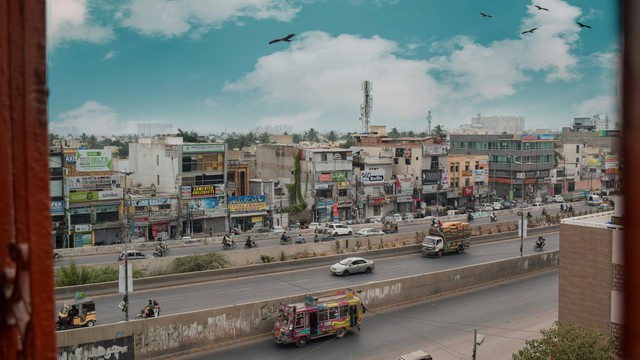The case for sewers
On World Toilet Day 2021 we take a look at the surprisingly controversial role of sewers in countering poor-quality sanitation in cities in the global South.


Pit latrines are very common in Kampala slums, Uganda (Photo: SuSanA Secretariat via Flickr, CC BY 2.0)
There is a massive deficit in provision for good-quality sanitation in cities in the global South. In 2020 only 15% of the urban population in low-income nations had sewer connections – for sub-Saharan Africa it was only 11%. Hundreds of cities have no sewers, and inadequate sanitation provision by other means, such as pit latrines.
I have long been puzzled by the anger generated by any consideration of sewers for addressing these huge deficits. An employee from one of the more progressive European aid agencies told me in confidence that the environment lobby in his country would not allow funding for sewer systems as they were seen as ‘unecological’. Sewers get little or no support from most aid agencies.
Even more strange is that many who see sewers as wrong live in homes connected to sewers. There is also little complaint about having a sewer connection from urban populations in high-income nations, where 92% are connected. Many cities in Latin America have close to universal coverage.
Simple and universal sanitation
At its most basic, sanitation needs include access to a toilet (preferably in the home) that can be used safely and in privacy – and where one’s dangerous and smelly toilet wastes, including faecal matter, toilet paper and household wastewater, are removed from the home and neighbourhood.
But choosing sanitation responses is more complicated – as is the issue of who chooses. What works best in any neighbourhood and wider city is greatly influenced by local context, including affordability for users and providers. There is clearly no point in having a sewer connection to the home if the water supply needed for flushing is irregular.
But it’s also wrong to promote toilet designs relying on on-site storage for which there is no room – space is always at a premium in cities.
Entire households may live in one 3x3m room. And pit latrines can’t be installed on each floor in multistorey residences. Pit latrines are often inaccessible to pit emptiers, although new technologies – including gulpers, nibblers, gobblers, and rammers – are seeking to address this.
So consideration must be made not only of toilet options but also of provision for on-site storing (for latrines and septic tanks), collection (as sewage) or emptying (faecal sludge from pits/septic tanks), and transport to treatment disposal facility/end use (sewers, road vehicles such as vacuum trucks).
In praise of sewers
Sewers may be expensive to install and seen as unecological, but they can bring huge health advantages for households and cities – if unit costs mean low-income households can afford to be connected. The benefits include:
- Toilets and sewers minimise risk of human contact with faecal matter
- Sewer connections take up much less space than pit latrines
- Sewers work well in multistorey buildings
- Sewers solve the problem of disposing of other household waste water. It is much cheaper to have a combined pipe system
- Sewers can provide emergency overflow for storm drainage
- Sewers do not require a collection/disposal service for each home or business, or the expensive transportation costs – especially if the treatment site is far from the collection point
- Sewers can help protect groundwater from contamination by excreta/waste water
- Sewers can be used to recycle wastewater for industry or agriculture, and
- Importantly, children are much more likely to use toilets than pit latrines.
Are sewer systems too expensive?
Many cities in middle-income countries have high coverage of conventional sewer systems. Sewer connections are often less expensive than on-site sanitation options, especially if consideration is given to recurrent running costs.
The following initiatives show some clever ways to lower costs.
- The Orangi Pilot Project (OPP) Research and Training Institute (PDF) in Pakistan made household sewer connections affordable to low-income residents by cutting costs and combining household, community and government resources. Communities did the ‘small pipes’ while government provided the ‘big pipes’. As a result hundreds of thousands of low-income households benefited
- The Community Organizations Development Institute (CODI) in Thailand supported community-led upgrading of informal settlements (PDF) that included connections to sewer systems, and
- The upgrading programme in Mukuru led by the Kenyan federation of slum dwellers, Muungano wa Wanavijiji, saw that sewers were essential when addressing the sanitation needs of large and very high-density informal settlements.
Many upgrading programmes for informal settlements include sewers. Some are managed and financed by city governments. Others are community-driven as in the examples above – although solutions need support from government to increase scale.
Successful sanitation initiatives had to find a balance between affordability and solutions that work well for children, women and men.
Shared or communal provision is often necessary because even the cheapest in-house latrine may be too expensive. Public toilets have a bad reputation but community-managed public toilets have shown how these can work well, and at lower cost if connected to a sewer.
In the absence of universal access to sewers, cities need to find an optimal combination of off-site and on-site sanitation options. On-site sanitation systems place enormous responsibility on households and private providers, and thus require considerable government capacity to regulate and enforce sanitation standards to ensure public health and safety.
The bottom line
City dwellers need good provision for sanitation when they’re outside the home. But most work in the informal economy and don’t have toilets at their workplace. Access to good quality, easily accessed sanitation is also needed when travelling, and at school for staff and pupils.
So while sewers are convenient, safe and sanitary, and can manage very large volumes of toilet wastes, they require a substantial capital investment on the part of the public sector and a regular and sufficient supply of water.
Most cities in the global South will require a combination of off-site and on-site solutions to meet the sanitation needs of their growing populations.
The Sustainable Development Goals (SDGs) require access to adequate and equitable sanitation for all by 2030. But a review of how governments were doing 2015-2020 showed many going backwards or being far too slow to meet SDG targets.
I’m not recommending sewers. What I am recommending is a choice of sanitation system in each location that works best for women, men and children in their homes, workplaces, markets, public spaces and schools.
The solution must be rooted in a local context based on what can be afforded, while addressing gender inequality issues and requirements of groups with special needs (such as those with limited mobility).
- This blog draws from the report 'Untreated and unsafe: solving the urban sanitation crisis in the global South'



